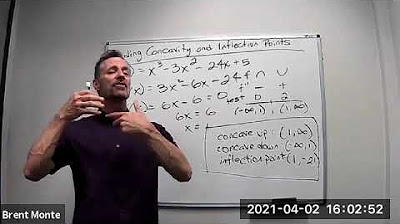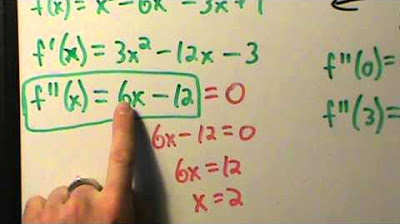Inflection Point Grade 12
TLDRThis educational video script explains the concepts of finding x-intercepts and inflection points in a mathematical function. To find x-intercepts, set y to zero. For stationary points, where the gradient is zero, take the first derivative and set it to zero. Inflection points, where the graph changes concavity, are found by setting the second derivative to zero. The script uses an example to illustrate these concepts, showing how to derive and solve for x to find the inflection point at x = -2/3. Additionally, it explains how to determine where a function is concave up by analyzing the sign of the second derivative, concluding that for x > -2/3, the function is concave up.
Takeaways
- 📍 To find the x-intercepts of a graph, set y to zero and solve for x.
- 🔍 To find stationary points, take the first derivative of the function and set it equal to zero.
- 📈 The second derivative is used to determine the concavity of a graph and its shape.
- 🔺 If the second derivative is negative, the graph is concave down.
- 🔻 If the second derivative is positive, the graph is concave up.
- 🔄 An inflection point occurs where the second derivative equals zero, indicating a change in concavity.
- 🔢 To find an inflection point, set the second derivative to zero and solve for x.
- 📉 The example given finds the inflection point by setting the second derivative (6x + 4) to zero, resulting in x = -2/3.
- 📈 To determine where a function is concave up, set the second derivative greater than zero and solve the inequality.
- 📊 For the given function, the graph is concave up when x > -2/3, as indicated by the positive second derivative (6x + 4).
- 📚 The script uses the function f(x) = 3x^2 + 4x + 4 to illustrate the concepts of stationary points and inflection points.
Q & A
How do you find the x-intercepts of a graph?
-To find the x-intercepts of a graph, you set y to zero and solve for x.
What are stationary points on a graph and how do you find them?
-Stationary points are points on a graph where the gradient is zero. To find them, you take the first derivative of the function and set it equal to zero.
What is the significance of the second derivative being equal to zero?
-When the second derivative is equal to zero, it indicates an inflection point on the graph, which is where the concavity changes from concave up to concave down or vice versa.
What does it mean for a graph to be concave up or concave down?
-A graph is concave up when the second derivative is positive, making it resemble a 'smiling' shape. It is concave down when the second derivative is negative, giving it a 'frowning' shape.
How do you determine if a point is an inflection point?
-A point is an inflection point if the second derivative of the function is zero at that point, indicating a change in concavity.
How do you find the inflection point of a function?
-To find the inflection point, you calculate the second derivative of the function and solve for when it equals zero.
What is the second derivative of the function f(x) = 3x^2 + 4x + 4?
-The second derivative of the function f(x) = 3x^2 + 4x + 4 is 6x + 4.
For what values of x is the function f(x) = 3x^2 + 4x + 4 concave up?
-The function f(x) = 3x^2 + 4x + 4 is concave up when the second derivative, 6x + 4, is positive, which occurs when x > -2/3.
What is the inflection point for the function f(x) = 3x^2 + 4x + 4?
-The inflection point for the function f(x) = 3x^2 + 4x + 4 is at x = -2/3.
How does the concavity of a graph change around the inflection point?
-Around the inflection point, the graph changes concavity from concave down to concave up or from concave up to concave down.
What does it mean for a graph to be 'concave 0'?
-'Concave 0' is a way to describe the inflection point where the graph is neither concave up nor concave down, indicating a transition point in the graph's curvature.
Outlines
📚 Finding X-Intercepts and Stationary Points
This paragraph explains the process of finding x-intercepts and stationary points on a graph. To find x-intercepts, the equation's y-value is set to zero. For stationary points, which are points where the gradient is zero, the first derivative of the function is taken and set to zero. The paragraph also introduces the concept of inflection points, which occur where the second derivative equals zero, indicating a change in the graph's concavity from concave up to down or vice versa.
📉 Understanding Inflection Points and Concavity
The paragraph delves into the concept of inflection points and the concavity of a graph. It describes how the second derivative being positive or negative indicates whether the graph is concave up (smiling) or concave down (sad face). The inflection point is identified as the point where the graph switches concavity, which can be found by setting the second derivative to zero. An example is given where the second derivative is calculated, set to zero, and solved for x, yielding the inflection point at x = -2/3.
🔍 Determining Concavity and Inflection Points
This section focuses on how to determine the concavity of a graph and locate inflection points. It emphasizes the importance of the second derivative in identifying concavity and explains that a positive second derivative indicates the graph is concave up. The process involves finding the first derivative, then the second derivative, and solving for when it is positive to find where the graph is concave up. An example is provided with a function, its first and second derivatives, and the conclusion that for x > -2/3, the graph is concave up.
Mindmap
Keywords
💡x-intercept
💡stationary point
💡gradient
💡first derivative
💡second derivative
💡concave down
💡concave up
💡inflection point
💡derivative
💡inequality
Highlights
To find x-intercepts, set y to zero.
Stationary points occur where the gradient is zero, found by setting the first derivative equal to zero.
The second derivative is used to find inflection points and analyze the shape of the graph.
Concave down shape indicates a negative second derivative, while concave up is indicated by a positive second derivative.
An inflection point is where the graph changes from concave down to up or vice versa, found by setting the second derivative to zero.
Inflection points are where the graph switches from one concavity to another.
To find an inflection point, take the second derivative and solve for when it equals zero.
Example given: finding the inflection point of a function by taking the second derivative and solving for x.
The inflection point for the given example is at x = -2/3.
The inflection point is where the graph changes concavity, either from concave down to up or up to down.
To determine where a function is concave up, find where the second derivative is positive.
Concave up is represented by a positive second derivative, indicating a 'smiling' graph.
For the given function, the graph is concave up when x > -2/3.
The graph's concavity changes at x = -2/3, with concave up to the right and concave down to the left.
Students are often tempted to incorrectly set the second derivative to zero when looking for concavity, rather than analyzing its sign.
Transcripts
Browse More Related Video

Point of Inflection - Point of Inflexion - f''(x)=0 - Definition - How to Find - Worked Example 1

Finding Concavity and Inflection Points

Points of inflection from the graphs of f, f' or f''

Calculus I - Concavity and Inflection Points - Example 1

Concavity, Inflection Points, and Second Derivative

Calculus I: Finding Intervals of Concavity and Inflection point
5.0 / 5 (0 votes)
Thanks for rating: